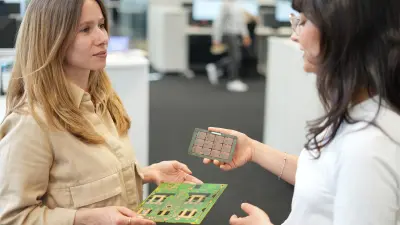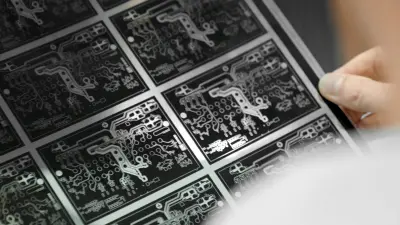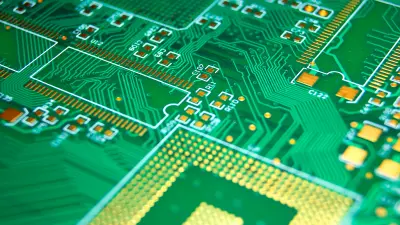Low-Temperature Co-fired Ceramic (LTCC) PCBs: engineering resilience for high-stress environments

In industrial applications where electronics must endure extreme heat, vibration, or corrosive conditions, Low-Temperature Co-fired Ceramic (LTCC) PCBs have become critical for reliability. Unlike traditional PCBs, LTCCs utilize ceramic substrates and multilayer co-firing processes to address limitations in high-frequency performance, thermal management, miniaturization, and thus overall reliability.
What are LTCC PCBs?
LTCC PCBs are multilayer ceramic circuits manufactured by stacking and co-firing ceramic sheets at temperatures between 850°C and 950°C. Unlike traditional PCBs made from epoxy resins or fiberglass, LTCCs use ceramic substrates, which offer better thermal conductivity, mechanical stability, and resistance to harsh environments. This process allows passive components like resistors to be integrated directly onto the board, reducing assembly complexity and saving space.
Key characteristics of LTCC technology include:
- High-frequency stability: Low dielectric loss makes LTCCs ideal for millimeter-wave frequencies (up to 100 GHz), such as 5G antennas and radar systems.
- Thermal conductivity: Ceramics dissipate heat more effectively than FR-4, reducing hotspots in high-power applications.
- Miniaturization: Integration of components enables compact designs.
- Durability: LTCCs are resistant to thermal shock, vibration, and chemical exposure, even in unshielded environments.
"What makes Low-Temperature Co-fired Ceramics technology particularly powerful is its ability to perform reliably in conditions where standard PCBs would fail," explains Mark Jagodzinski, Director of LTCC Manufacturing at Bosch USA. "We've seen cases where even after extreme thermal exposure that melted the housing, the LTCC inside remained functional — that's the level of reliability we're talking about."
LTCC vs. traditional PCBs: why choose ceramics?

Low-Temperature Co-fired Ceramics excel in specialized applications where reliability is non-negotiable. Here’s how they compare:
| Feature | LTCC PCBs | Traditional PCBs |
|---|---|---|
|
Feature
Material
|
LTCC PCBs
Ceramic layers
|
Traditional PCBs
FR-4, polyimide, or other polymers
|
|
Feature
Thermal conductivity
|
LTCC PCBs
High (3–20 W/mK)
|
Traditional PCBs
Low (0.3–1.5 W/mK)
|
|
Feature
Frequency range
|
LTCC PCBs
Up to 100 GHz
|
Traditional PCBs
Limited at high frequencies
|
|
Feature
Component integration
|
LTCC PCBs
Embedded passives
|
Traditional PCBs
Surface-mounted components
|
|
Feature
Cost
|
LTCC PCBs
Higher initial cost
|
Traditional PCBs
Cost-effective for high volumes
|
LTCCs occupy a niche, representing only a fraction of global PCB production, according to industry estimates. They thrive in applications where performance outweighs cost, such as aerospace avionics, automotive control units, and implantable medical devices. As John Farmer, a technical expert at Bosch USA, notes: "LTCCs won’t replace traditional PCBs, but they solve critical challenges where standard boards fail — like preventing components from catching fire in high-stress environments."
Industrial applications: where Low-Temperature Co-fired Ceramics excel

1. Automotive electronics
LTCCs are used in various vehicle electronic control modules (ECMs) and sensors, where exposure to extreme temperatures (up to 150°C) and vibration is unavoidable. For example, LTCC-based exhaust sensor control units monitor emissions in real time. And transmission control units function for the life of a vehicle even while submerged in hot transmission fluid.
2. Aerospace and defense
Radar systems and satellite communications leverage LTCCs’ high-frequency stability and resistance to radiation.
3. Medical devices
Implantable devices, such as pacemakers, benefit from LTCCs’ biocompatibility and long-term reliability in humid, ion-rich environments.
4. Industrial IoT
Sensors in oil and gas drilling equipment use LTCCs to withstand pressures exceeding 1,300 bar and temperatures over 200°C.
Challenges in LTCC adoption
- Design complexity
Embedding passive components requires precise layout rules to avoid signal interference. Designers must account for shrinkage inconsistencies during firing, though advanced Bosch LTCC techniques like zero-shrink sintering mitigate this. - Cost barriers
LTCC production costs can be 3–5x higher compared to standard PCBs due to material expenses (e.g., silver conductors) and batch manufacturing processes. - Scalability limitations
Most LTCC panels are small (≤2x2 inches) to minimize warping during sintering, limiting their use in larger systems.
For engineers considering LTCCs, Farmer advises: "Start early in the design phase. And leverage our experience to balance performance and cost."
The road ahead for LTCC technology
As 5G, autonomous vehicles, and Industry 4.0 push electronics into harsher environments, demand for LTCCs is projected to grow at 6–8% annually. Emerging alternatives like ultra-low-loss organic substrates could compete in high-frequency niches, but LTCCs’ mechanical resilience ensures their relevance in mission-critical applications.
“LTCCs won’t replace traditional PCBs, but they solve critical challenges where standard boards fail — like preventing components from catching fire in high-stress environments.”
Bosch’s know-how in LTCC innovation

Bosch’s journey with Low-Temperature Co-fired Ceramic technology began in the 1990s, driven by the need for robust control units in automotive braking systems. Partnering with material suppliers, Bosch developed LTCCs capable of withstanding transmission fluid immersion, extreme heat, and mechanical stress. Today, their US plant in Anderson, South Carolina is a hub for LTCC manufacturing, serving the automotive industry with vehicle electronic control modules and sensors that meet stringent automotive and industrial standards, e.g. ISO/TS 16949 or IPC-6012.
LTCC PCBs represent an important technology for applications where standard circuit boards reach their limits. Through decades of manufacturing and design experience, Bosch has established itself as a major player in this specialized field. For engineers and designers facing challenging electronic requirements, understanding LTCC capabilities is essential. Contact our team today to explore how Low-Temperature Co-fired Ceramics technology can enhance your next project's reliability and performance.
Would you like to find out more about LTCCs? Contact us today — we will be happy to advise you on your specific requirements and show you how you can benefit from our support.




